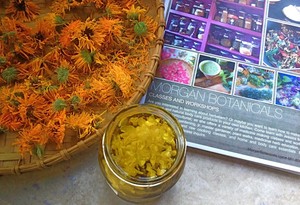15 Oct Thu 2009
Who Says You Can't Eat The Flowers

There are so many flowers that can be eaten. The culinary use of flowers dates back thousands of years to the Chinese, Greek and Romans. Today there is a resurgence of interest in edible flowers, and I can see why. Flowers add texture, interest, and beauty to dishes that could otherwise be simply boring.
Collect your flowers at the optimum time. Pick them when they are fully open in the coolest part of the day. Flowers that are not fully open (unless buds are desired) or those starting to wilt should be avoided. Sample a flower or two for flavor before harvesting. Remove the pistils and stamens because the pollen can detract from the flavor of the flower as well as cause allergic reactions in susceptible individuals. After harvest, place long-stemmed flowers in water and then in a cool location. Short stemmed flowers should be placed between layers of damp paper toweling or in a plastic bag in the refrigerator. Immediately before using, gently wash the flowers to remove dirt and check for insects.
It is important to know what part of the flower is edible before consuming. Only the petals of some flowers such as Rose, Tulip, Yucca and Lavender are edible. Separate the flower petals from the rest of the flower just prior to use to keep wilting to a minimum. Roses, Dianthus, English daisies, and Marigolds have a bitter white area at the base of the petal where it was attached to the flower. Break or cut off this portion before using. With a little research and a culinary imagination, you can change your ordinary dish into a culinary masterpiece!
Here's a list of flowers known for culinary use:
- Calendula(Calendula officinalis)
- Carnations (Dianthus caryophyllus
- Chrysanthemums (Chrysanthemum coronarium)
- Clover (Trifolium species)
- Cornflower (Centaurea cynaus)
- Dame's Rocket (Hesperis matronalis)
- Dandelions (Taraxacum officinalis)
- Day Lilies (Hemerocallis species)
- English Daisy (Bellis perennis)
- Apple Blossoms (Malus species)
- Banana Blossoms (Musa paradisiaca)
- Citrus Blossoms (orange, lemon, lime, grapefruit, kumquat)
- Elderberry Blossoms (Sambucus spp)
- Fuchsia (Fuchsia X hybrida)
- Garden Sorrel (Rumex acetosa)
- Gladiolus (Gladiolus spp)
- Alliums (leeks, chives, garlic, garlic chives)
- Angelica (Angelica archangelica)
- Anise Hyssop (Agastache foeniculum)
- Basil (Ocimum basilicum)
- Bee Balm (Monarda didyma)
- Borage (Borago officinalis)
- Burnet (Sanquisorba minor)
- Chervil (Anthriscus cerefolium)
- Chicory (Cichorium intybus)
- Cilantro/Coriander (Coriander sativum)
- Chamomile (Chamaemelum noblis)
- Dill (Anethum)
- Fennel (Foeniculum vulgare)
- Ginger (Zingiber officinale)
- Jasmine (jasmine officinale)
- Lavender (Lavandula angustifolia)
- Lemon Verbena (Aloysia triphylla)
- Marjoram (Origanum majorana)
- Mint (Mentha spp)
- Oregano (Origanum vulgare)
- Rosemary (Rosmarinus officinalis)
- Safflower (Carthamus tinctorius)
- Sage (Salvia officinalis)
- Savory (Satureja hortensis)
- Thyme (Thymus spp.)
- Hibiscus (Hibiscus rosa-sinensis)
- Hollyhock (Alcea rosea)
- Honeysuckle (Lonicera japonica)
- Hyacinth (Brodiaea douglasii)
- Impatiens (Impatiens wallerana)
- Johnny-Jump-Ups (Viola tricolor)
- Lilac (Syringa vulgaris)
- Linden (Tilla spp.)
- Marigold (Tagetes tenuifolia - aka T. signata)
- Nasturtiums Tropaeolum majus)
- Pansy (Viola X wittrockiana)
- Peony (Paeonia lactiflora)
- Phlox, Perrennial Phlox (Phlox paniculata)
- Pineapple Guave (Feijoa sellowians)
- Primrose (Primula vulgaris)
- Queen Anne's Lace (Daucus carot
- Roses (Rosa rugosa or R. gallica officinalis)
- Scented Geraniums (Pelargonium species)
- Snap Dragon (Antirrhinum majus)
- Sunflower (Helianthus annus)
- Sweet Woodruff (Galium odoratum)
- Tulip Petals (Tulipa)
- Arugula (Eruca vesicaria)
- Radish Flowers (Raphanus sativus)
- Scarlet Runner Beans (Phaseolus vulgaris)
- Pea Blossoms (Pisum species)
- Squash Blossoms (Curcubita pepo)
- Violets (Viola species)
- Yucca Petals (Yucca species)
Only eat flowers that have been positively identified and you are sure they are edible. If uncertain, consult a good reference book on edible flowers prior to consumption.
Please email any questions to herbalist@morganbotanicals.com.
Follow me on Twitter - MorganBotanical
Copyright 2009. All rights reserved. Jessica Morgan, M. H., Morgan Botanicals.
Disclaimer - The information provided in this article is for informational purposes only and is not intended as a substitute for advice from your physician or other health care professional. You should not use the information in this article for self-diagnosis or to replace any prescriptive medication. You should consult with a health care professional before starting any diet, exercise or supplementation program, before taking any medication, or if you have or suspect you might have a health problem, suffer from allergies, are pregnant or nursing.
Jessica Morgan, M.H.

